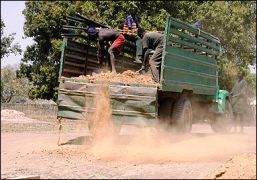Roads key to post-war reconstruction of south Sudan
RUMBEK, Sudan, Jan 19 (AFP) — The construction of a road network for southern Sudan will be crucial to rebuilding a region that, after two decades of civil war, has virtually none at all.

|
|
A southern Sudanese crew repairs roads in the provisional capital of Rumbek. Reparing infrastructure is a priority of Sudan People’s Liberation Movement. (AFP). |
Most of those that do exist are usable only in the dry season and all are unpaved and in desperate need of repair.
“Very few people were ready to put their transport on the road,” said the director of the World Food Programme’s regional sub-office, Constance Lewanika.
She said the problem had seriously hampered the UN agency’s efforts to distribute relief aid and led to inflated prices for the few available commodities.
As a result, the WFP decided to get into road building, “primarily for our purposes” but also for the overall socio-economic development of the region.
Even now, around 80 percent of all food aid for southern Sudan and the adjacent conflict zones of the Nuba Mountains and southern Blue Nile is delivered by costly flights from the Kenyan border town of Lokichoggio.
A round trip by a C-130 cargo aircraft delivers 18 metric tonnes of aid but costs 20,000 dollars, said WFP regional spokesman Tarcisius K. Nitta.
Bringing in food by land via Uganda is much cheaper but the poor quality of the road meant it used to take as much a month for the convoys to cover the 600 kilometres (370 miles) from the border to the WFP’s warehouses in the provisional regional capital of Rumbek.
Trucks frequently got stuck in the mud and their cargoes of grain had to be offloaded while they are pulled free.
So the agency set about repairing the worst stretches of the road using funds earmarked for emergency operations, before launching an appeal for donations to cover full repairs to the entire length from the border town of Kaya to Rumbek.
The initial phase cost 20 million dollars and the WFP says it needs around 90 million dollars to complete the project.
So far, a 400 kilometre (250 mile) stretch from the border has been upgraded by Kenyan contractor Civicon.
A second Civicon team has now begun work in the other direction and the two teams hope to meet up by the end of the year.
The work includes removing mines, widening the roads from the current width of six metres (yards) to 12, and shaping and arching them.
“They are in the process of making it a proper road,” said Civicon site manager Robert Bass, as graders and rollers levelled the surface.
Bass and his crew put in at least 10 hours a day in an effort to meet the December deadline. “We want to show them we can do it,” he told AFP.
The results are already paying off. The journey time from the border has been slashed to between three and five days, sharply reducing transport costs.
“There will be more traffic, more trade coming in,” Bass predicted.
Prices of basic commodities such as sugar, maize, soap, salt and fuel have all fallen.
“They are down about 20 percent,” said William, a market trader in Rumbek.
Lewanika said that repairing the road had led to “increased movement of people” and “opened up the region for socio-economic development.”
“We have seen a dramatic increase in the amount of merchandise in the market,” she said.
The new road will also play a vital role in the massive task of bringing home the 3.5 million people estimated to have fled their homes during the war.
And the project has created jobs for scores of Sudanese, including Salah, who works for Civicon, driving a truck.
He earns about 375 dollars a month and hopes to use the money to send his four children to school. None has been in a classroom before.
